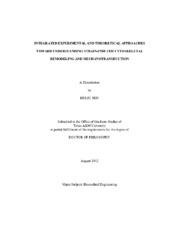Integrated Experimental and Theoretical Approaches toward Understanding Strain-Induced Cytoskeletal Remodeling and Mechanotransduction
Abstract
Actin stress fibers (SFs) are mechanosensitive structural elements that respond to applied strain to regulate cell morphology, signal transduction, and cell function. The purpose of this dissertation is to elucidate the effects of mechanical stretch on cell mechanobiology via the following three aims. First, a sarcomeric model of SFs was developed to describe the role of actomyosin crossbridge cycling in SF tension regulation and reorientation in response to various modes of stretch. Using model parameters extracted from literature, this model described the dependence of cyclic stretch-induced SF alignment on a two-dimensional (2-D) surface on positive perturbations in SF tension caused by the rate of lengthening, which was consistent with experimental findings. Second, the sarcomeric model was used to predict how stretch-induced pro-inflammatory mechanotransduction depends on the mode of strain application. Together with experimental data, the results indicated that stretch-induced stress fiber alignment, MAPK activations and downstream pro-inflammatory gene expressions are dependent on SF strain rate (and related changes in SF tension) rather than SF turnover. Third, to produce biocompatible materials that are both mechanically resilient under (physiological) load and also mechanosensitive, a novel hybrid engineered tissue was developed that transmits strain stimuli to cells residing in three-dimensional (3-D) collagen microspheres. However, the macroscopic stress is largely borne by a more resilient acellular polyethylene glycol diacrylate (PEGDA) hydrogel supporting the microspheres. Careful analysis indicated that cell alignment occurs prior to significant collagen fibril alignment.
Subject
cytoskeletal dynamicsorientation
MAPK mechanotransduction
mechanical stretch, myosin, mechanotransduction
Cell mechanics
Modeling
Citation
Hsu, Hui-Ju (2012). Integrated Experimental and Theoretical Approaches toward Understanding Strain-Induced Cytoskeletal Remodeling and Mechanotransduction. Doctoral dissertation, Texas A&M University. Available electronically from https : / /hdl .handle .net /1969 .1 /ETD -TAMU -2012 -08 -11792.


